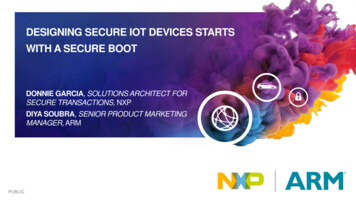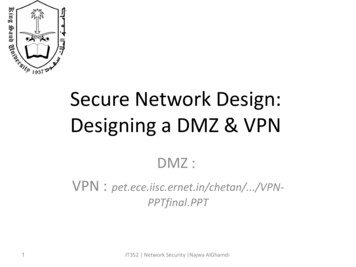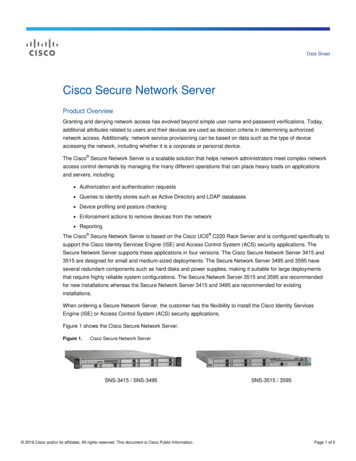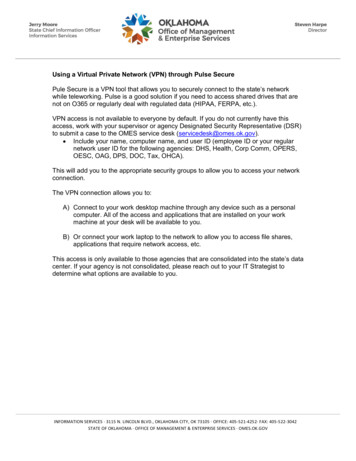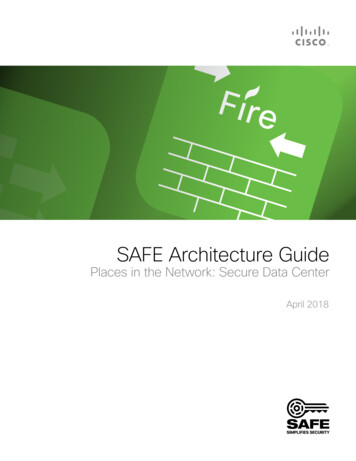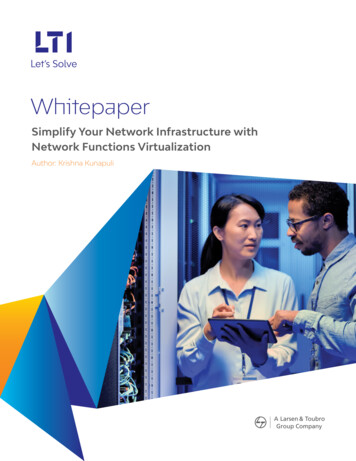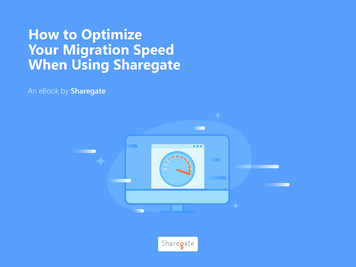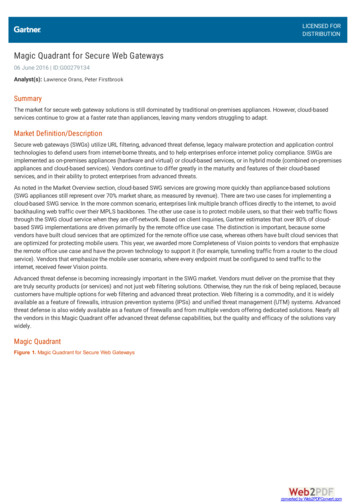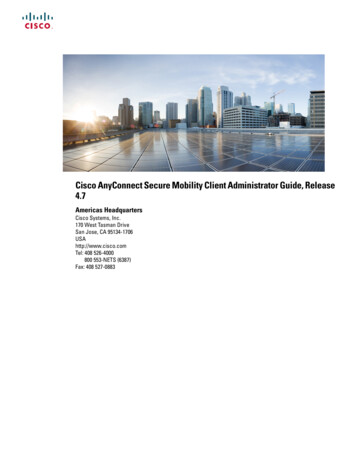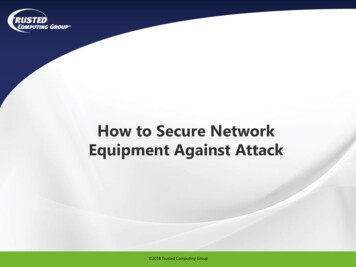
Transcription
How to Secure NetworkEquipment Against Attack 2018 Trusted Computing Group
Webcast Logistics 2018 Trusted Computing Group
Today’s PresentersBill SulzenTechnical LeaderCisco SystemsMichael EckelSecurity TechnologistHuawei Technologies 2018 Trusted Computing GroupSteve HannaSenior PrincipalInfineon Technologies3
Agenda Threats to network equipmentLocking down firmwareIntroduction to trusted computingNetworking applications for trusted computingFrom guidance to realityCall to actionReferences 2018 Trusted Computing Group4
THREATS TO NETWORK EQUIPMENT 2018 Trusted Computing Group
Threats to Network Equipment Network equipment is critical infrastructure Threats include: Data theft Denial of service Launch point for further Damage to networkattacksequipment Recent headlines:“Russian hackers mass-exploit routers in homes, govs, and infrastructure1”“Over a million vulnerable fiber routers can be easily hacked 2”“Wikileaks Unveils ‘Cherry Blossom’ – Wireless Hacking System3”1. nfrastructure/2. rable-fiber-routers-can-be-easily-hacked/3. ter-hacking-tool.html 2018 Trusted Computing Group6
Securing Network Infrastructure Today’s scope: Embedded networking systems like routers,firewalls, switches, industrial and IoT gateways It’s important to consider security at all levels– But particularly firmware 2018 Trusted Computing Group7
LOCKING DOWN FIRMWARE 2018 Trusted Computing Group
Firmware Attacks Why so much focus on firmware attacks? It’s the first link in the chain of trust– If you skip a link in the chain, the remaining links cannotbe trusted Firmware hacks are usually persistent– Firmware is not usually updated or examined Good for stealthy attacks!– Hacks can be un-removable**Without a hardware programmer 2018 Trusted Computing Group9
Securing FirmwareTwo simple steps:1. Make sure that the OS cannot modify firmware– This usually needs some kind of hardware help to lockboot flash memory2. Make sure that the BIOS (or U-Boot or whatever) won’tupdate itself without checking a signature on the new image 2018 Trusted Computing Group10
Secure Boot Secure boot(*) is a process that ensures that the device bootsunmodified, authorized software Secure boot is achieved by providing an unbroken “chain of trust” fromthe first instruction executed after reset through to the OS prompt.Loader checksKernelSignaturesbefore handoffFirmware checksLoader Signaturebefore handoffFirmware1.Initialize hardware2.Check LoaderSignature Loader1.Locate OS Image2.Check KernelSignatures KernelStart OS (e.g., Linux)Check and run DaemonsCore Root of Trust*aka Verified Boot 2018 Trusted Computing Group11
INTRODUCTION TOTRUSTED COMPUTING 2018 Trusted Computing Group
What is a Trusted System? Predictable, even under stress Trust based on experience and/or evidence Trust based on fundamental properties:– Identity– Integrity 2018 Trusted Computing Group13
Trusted Computing Group (TCG)Open Standards for Trusted Computing TCG is the only group focused on Trusted Computing standards You know TCG for our technical specs & guidance such as:– Trusted Platform Module (TPM ISO 11889)– Self-encrypting drives (SED)– Trusted Network Communications (TNC) TPM specification implemented in more than a billion devices– Chips integrated into PCs, servers, printers, kiosks, industrialsystems, and many embedded systems 2018 Trusted Computing Group
Trusted Platform Module (TPM)The Standard Hardware Root of Trust Trusted Platform Module (TPM)– Self-contained security processor– Inexpensive & small ( 0.1 watt, 1)– Connects to inexpensive processor buses TPM provides:–––––Secure storage of boot state ( hashes of objects)Secure storage of runtime state ( hashes of software applications)Secure storage of cryptographic secrets (e.g. private keys)Cryptographic-quality Random Number GeneratorResistance to physical attack (i.e. reverse-engineering) to keep private keys private Specified by Trusted Computing Group, a standards group 2018 Trusted Computing Group15
NETWORKING APPLICATIONS FORTRUSTED COMPUTING 2018 Trusted Computing Group
TCG Network Equipment Guidance TCG Guidance for Securing Network Equipment document Developed by TCG members, many involved in networking:– Cisco, HPE, Huawei, Juniper, and others Intended to help equipment vendors useTCG technology to secure network infrastructure Includes use cases, building blocks,and implementation guidance Published January 17, -securingnetwork-equipment 2018 Trusted Computing Group17
Applications for TPM inNetworked Gear Cryptographic Random Number Generator (RNG)– Unpredictable numbers are critical to secure cryptography Sealing secrets– Keep VPN keys and other data-at-rest secure IEEE 802.1AR cryptographic device identification– Use spoof-resistant cryptographic means to identity devices Software attestation / health check– Use records kept by the TPM to fingerprint each software module run and many others 2018 Trusted Computing Group18
Random Number GeneratorEssential for Secure Protocols Protocols like IPsec, SSH, SSL and TLS use cryptographic keys Keys are often generated within the embedded device itself Keys are like passwords:If you can guess the key, you can break the protocol. Cryptographic keys are typically generated from randomnumbers Without hardware help, computer algorithms can onlygenerate pseudo-random sequences, not truly randomnumbers Most TPMs contain a physical source of randomness (akaentropy) which can be used to generate reliable keys 2018 Trusted Computing Group19
Sealing SecretsEnsure that secrets remain secret! The TPM can be used to protect secrets like:– VPN shared-secret keys– Disk Encryption keys Configure the TPM so it will only decrypt thesecrets for use when the platform is in aspecified state, e.g.– Known, unmodified OS– Specific platform configuration– User password 2018 Trusted Computing Group
IEEE802.1AR Secure Device IdentityProves Which Device is Which Many embedded devices are ‘remote’ and difficult toprotect or even identify reliably. The TPM can be configured with a uniquecryptographic identifier based on device serialnumber – based on IEEE spec 802.1AR (DevID) Public Key Cryptography allows the device to assertits identity and then prove possession of a difficult-tosteal private key stored inside the TPM 2018 Trusted Computing Group21
How Would a DevID be Used? Inventory– Ensure the devices you put in place are still there VPN login– Use DevID for remote login, so only authorizeddevices are allowed on your network Zero-Touch configuration– Ensure that only authorized devices can call in toobtain configuration 2018 Trusted Computing Group22
Attestation and Measured BootProves What Software was Launched on your Device Secure boot works well for deterministic early stages of boot But multi-core processors tend to be less predictable once theOS layer starts up The TPM can be used to record “measurements” ( hashes) ofeach executable run The TPM can then return those measurements to amanagement station later, signed by a key that only the TPMcan know “Attestation” provides cryptographic assurance of whichexecutables actually were run. 2018 Trusted Computing Group23
FROM GUIDANCE TO REALITY 2018 Trusted Computing Group
Real-World Implementations So we have a great document– TCG Guidance for Securing Network Equipment How is that becoming real? 2018 Trusted Computing Group
RSA Conference 2015Cisco and Infineon Secure the IoT with TPM Remote attestation with IoT gateway, router, and server TPM-Protected Identity on all systems Rejects unauthorized or compromised systems 2018 Trusted Computing Group
RSA Conference 2016Huawei and Infineon Secure the IoT with TPM Remote attestation with IoT gateway, router, server, and VMsARM, PPC, and X86 platforms equipped with a TPMServer running QEMU/KVM with vTPMOne VM acted as verifier for attestationsLayer binding between VM and hypervisor 2018 Trusted Computing Group
Mobile World Congress 2018Juniper and Infineon Protect Keys and Configs with TPMKey image12TPMDecryptCPUSystem Disk34SRX-300 FirewallDRAMUnlockedsecrets Sensitive Data decrypted using key from TPM at boot time Decrypted secrets may be erased from DRAM when done to avoid exposure Secrets cannot be retrieved from a purloined system disk 2018 Trusted Computing Group
CALL TO ACTION 2018 Trusted Computing Group
What Can You Do? Review Network Equipment Guidance to learnmore:– ring-network-equipment/ If you build network equipment,– Consider adopting the described techniques If you buy network equipment,– Ask your network equipment providers whatthey’re doing about today’s advanced threats 2018 Trusted Computing Group30
REFERENCES 2018 Trusted Computing Group
Relevant Documents Trusted Computing Group:– Network Equipment documents:– t/TPM computinggroup.org/wpcontent/uploads/TPM Keys for Platform Identity v1 0 r3 d-Boot/ba-p/281251TPM & Secure lize/manufacture/desktop/secure-boot-overview 2018 Trusted Computing Group32
TPM Software tpm2-tss– https://github.com/tpm2-software/tpm2-tss IBM TSS– https://sourceforge.net/projects/ibmtpm20tss/ Mocana IoT Trust Platform– https://www.mocana.com/solutions OnBoard Security TSS– https://www.onboardsecurity.com/products/tss 2018 Trusted Computing Group
Questions?Post Your Questions NowThank You! 2018 Trusted Computing Group
Contacting Trusted Computing putinggroup.orgLinkedIn Trusted Computing er: @TrustedComputinYouTube tTalk webcasts (free): www.brighttalk.com,search “trusted computing” for library ofdemonstrations and presentations 2018 Trusted Computing Group
–VPN shared-secret keys –Disk Encryption keys Configure the TPM so it will only decrypt the secrets for use when the platform is in a specified state, e.g. –Known, unmodified OS –Specific platform configuration –User password
